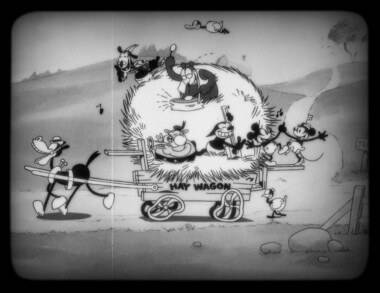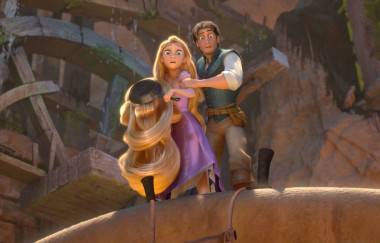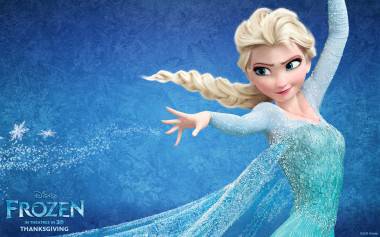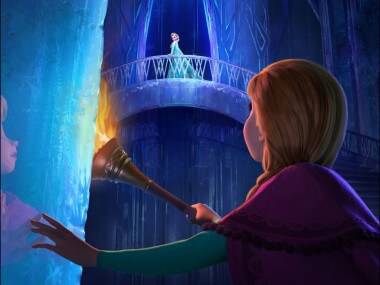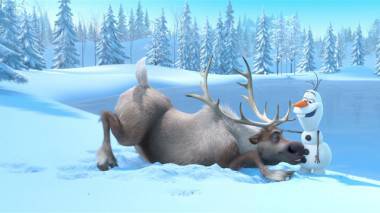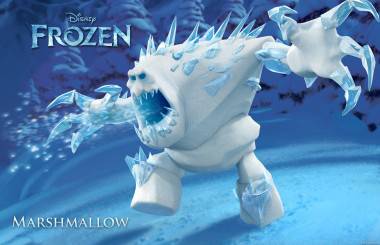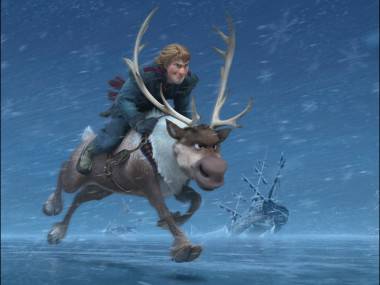Frozen Review
First up at this preview screening was a brilliant surprise bonus for someone such as myself who is into their animation history. In fact so well executed is the short film Get a Horse! that until the twist came it had me fooled into thinking I was seeing an early Mickey Mouse classic I hadn’t previously seen. Although to be fair, perhaps I should have been alerted to this by being asked to put on the 3D glasses!
(Alert, the following paragraph could be considered a spoiler for this short!)
When the characters start to burst out of the screen and dance around the ‘stage’ in 3D, instead of, as I usually would, being irritated by the pointless 3D-isation of a 2D icon, I was charmed by the best 3D-ification (is there a proper word for this process!) of an old character I’ve seen so far. Not only are the 2D characters totally faithful to their versions of 75 years ago, but so, amazingly, are the 3D characters. Veteran animation master Eric Goldberg supervised the 2D animation’s perfect recreation of 1920s stylizations and this was successfully carried through the 3D, with for instance the manic rhythmic movement of the characters who remain almost entirely in near-profile and the thing of the ears staying perfectly round on the head from any angle. I understand this short will be accompanying Frozen on its theatrical release and, for anyone with a love of animation styles of the past, is worth the admission price alone.
Frozen also carries strong links with Disney’s past, being first in development as an animated film at the studio in the 1940s along with other Hans Christian Anderson fairy tales, only to be abandoned, and then, like The Little Mermaid, resurrected in modern times.
This legacy also extends to Walt Disney’s proud traditions of full no expense spared R&D in the art of animation, as established in the 1920s and carried through till his death. This is maintained in the legacy that Frozen carries from the studios recent past, with the development period led by master 2D animator Glen Keane that anticipated the making of Tangled, intended to bring the “warmth and intuitive feel” of traditional drawn animation into the modern world of CG animation.
This drive to raise quality thresholds led to discussions such as the now famous “Best of Both Worlds” seminar where the animators debated the pros and cons of the techniques new and old, creating a wish list of ways to use the latest technology to create new tools to blend the two. Keane stated that he was aiming to make the computer “bend its knee to the artist” and become “as pliable as a pencil” to ultimately achieve his vision of a “three dimensional drawing”. Whether his vision was ever fully achieved before he somewhat mysteriously left the project and the studio I couldn’t say, but the impressive results of his drive to put the soul back into computer animation can clearly be seen in this latest film as much as in Tangled. It has resulted in some tremendously subtle and engaging performances from the animated characters that, as all good acting should, whether live action or animation, makes the characters seem driven by a real inner life force rather than outside direction or puppetry.
This blend of techniques seems to often achieve the realism of motion capture but with the soulfulness and fluidity of drawn animation. From what I can gather the pipeline does not involve any kind of performance capture but after the early blocking out stage, the scenes are animated in 2D pencil tests and then also acted out in live action, with the animator using a combination of the two for reference. Referring back again to the (first?) Disney Golden Age I guess this is a modern day take on the kind of combination of hand drawn motion and rotoscope that was used in Disney classics from Snow White onwards.
Aside from the technical achievements and craftsmanship on show, you’ve got to like a film which features a song (“The First Time in Forever”) in which the lonely princess in an empty castle complains “Why have a ballroom with no balls !” This and the other big musical set pieces such as “Let it Go” have the razzmatazz and quality you might expect in a West End/ Broadway musical and don’t feel like they are slowing the plot down as can sometimes be the case.
The story concerns two princesses, the younger Anna and the soon to be queen Elsa. The problem is Elsa has powerful telekinetic powers that she finds difficult to control, especially when angry, and so the girls are kept isolated from each other and the world outside in the castle until coronation day. Unfortunately this day doesn’t go quite as planned and the young queen gets angry, causes more mayhem and flees the kingdom. The bulk of the story concerns Anna’s quest to reunite with her beloved elder sister and save the kingdom from the eternal winter Elsa has inadvertently and unknowingly caused. Directed by Chris Buck (Tarzan director and one of the many great names to come out of Brad Birds legendary 1987 short Family Dog) and Jennifer Lee (writer of Wreck it Ralph), the story zips along at a fair old pace and is generally entertaining and suspenseful. Although perhaps not containing any period of sustained excitement as the extended ‘theme park ride’ type chase sequence in Tangled, it has got a fair few edge of seat ‘go on go on’ type moments.
I’ve managed to keep my cynical old git tendencies in check so far but as one of the lessons in the film is to let your true feelings show, I feel I have to “Let it Go” and say that for me the film takes a bit of a downturn when Olaf the Snowman moves to centre stage. His design seems a bit crude and over cartoony in the context of the rest of the film and in general to me the character seemed trying to recreate the gentle idiot character of Sid the Sloth from Ice Age, except more annoying.
I suspect I wasn’t alone in this as several parents around me took the opportunity of Olaf’s song “Any Day” to grab their kids and ‘drift’ (see what I did there- it’s a snow word) away to the ‘rest room’ as they say stateside. The thought did occur to me at this point that an innovative Disney story idea might be make an animated film without an annoying sidekick, but at least in this case his role doesn’t really begin until half way through the film and then ended when.. actually where did he end up?
Now there probably was some satisfactory end to Olaf’s journey that I can’t remember, but this does bring me to another minor quibble with the film. Like Tangled, Frozen features many characters, which adds to the richness of course, but they do seem to enter and leave the narrative quite abruptly at times which can feel somewhat forced and unresolved. In Denmark, the home of Hans Christian Anderson and (a Disneyfied version of which) is where this story is set, they have an expression for this convenient kind of unexplained plot point: “A troll jumps out of a box”. Now as well as almost exactly describing the ending of Tangled, this kind of feels like it also describes moments in Frozen, with the story arcs of the (carefully avoiding any spoilers) “bad guys”, or the general absence of them, and yes, the trolls.
Which is my final moan, the trolls are also kind of superfluous and annoying, not least because they reminded me a bit of Smurfs (shudder). But hey, lets face it I’m not exactly the target audience and to be honest my six year old daughter adored every minute; trolls, Olaf, wacky slapstick jokes, goofy romance moments, every last detail.
If these modern day reworkings of fairy tales are to carry the same power and deep appeal as the originals, they should also work as parables, with an undercurrent that teaches about good, evil and other shades of morality in-between, and gives life lessons to their young modern audience.
In the case of Frozen among the life lessons I could deconstruct were the usual one about it being healthy to show your true feelings but here this was balanced by showing the dangers of unrestrained teenage hormonal emotion. The romance story was also made more complex here, and therefore realistic, by having Anna torn between two love interests, and (spoiler alert!) a good warning is given about the possibility of the longing for true love causing someone to fall for the first attractive person they meet.
Other touches reminded me of other Disney interests, the super powers angle felt like a nod to Disney’s new cash cow Marvel, while the idea of having to hide super ice powers and a bad guy ‘monologing’ reminded me of the The Incredibles, another great Disney franchise in waiting. Like Maximus the Horse in Tangled, the funniest character in Frozen was actually a non-speaking animal, Sven the Reindeer, who’s cry was weirdly like Chewbacca, a character from another recent Disney uber-franchise mega-purchase.
The 3D was razor sharp in my screening and the environments are gorgeous, with beautiful ice designs that grow in immense fractal patterns and the scattering soft snow dynamics replacing the hair in Tangled as an un-credited co star of the film. Another plus point for me was the absence of ‘A-list’ names in the voice cast, a pointless exercise in budget inflation in my opinion and a distraction from the real stars of these films, the creators and animators.
With the release of this film it should be acknowledged that in taking over at Disney, John Lassiter has impressively turned around the studio that a few years ago moved hesitantly into 3D CG with the so-so releases of Dinosaur, Chicken Little and Meet the Robinsons. This team has morphed into a CGI powerhouse, that with Tangled, Wreck it Ralph and now Frozen is arguably pulling ahead of Pixar, the company Lassiter created and the previous undisputed market leader. In fact he has pulled the two studios so close that now as Pixar is making films like Brave, another European set princess film with a modern leaning, its getting hard to distinguish between the separate identities.




